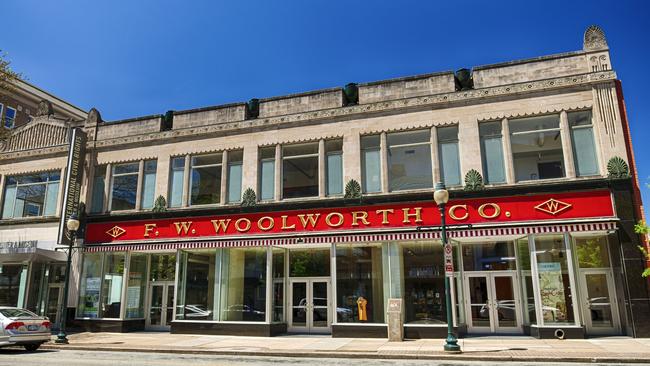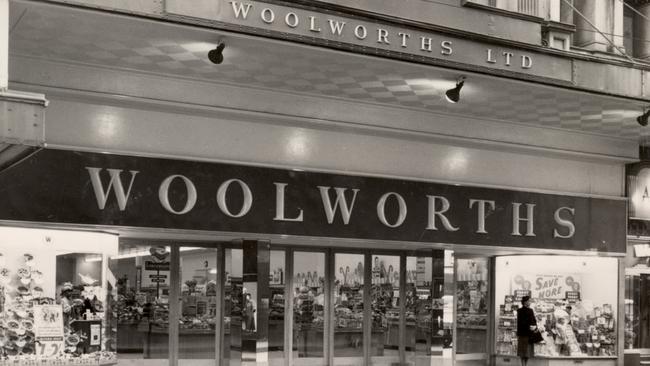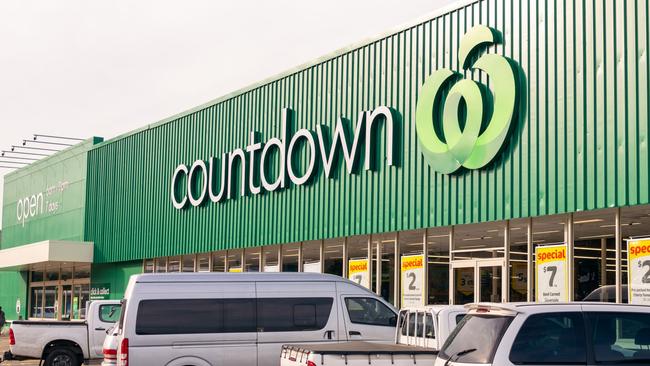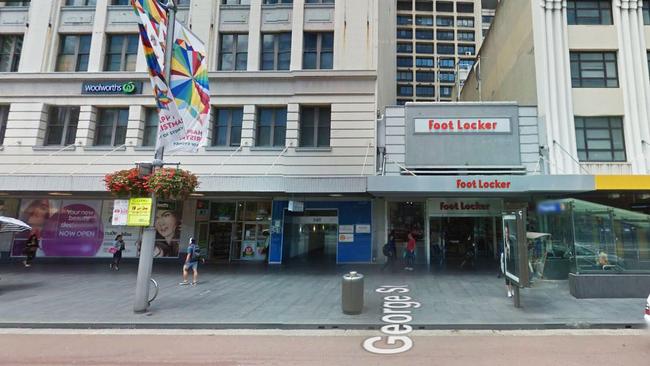Woolworths is only called ‘Woolworths’ because of a cheeky dare in 1924
It’s one of our biggest brands, but were it not for a cheeky dare in 1924 and an oversight far away in New York, we might not be shopping at Woolworths today.

Retail
Don't miss out on the headlines from Retail. Followed categories will be added to My News.
If you were to think of some of Australia’s most famous brands, Vegemite and Tim Tams might come to mind; perhaps Cherry Ripe and Darrell Lea. All of which are sold within the walls of another of Australia’s most famous brands – Woolworths.
According to some number crunching by advertising agency WPP, Woolworths is Australia’s most valuable retail brand and the fifth most valuable overall.
It’s worth a cool $10 billion, and only three big banks and Telstra are more valuable, but considering the year the banks have had, Woolies may have gone up a notch or two.
But were it not for a dare in Sydney in 1924, and a careless oversight 16,000km away in New York, we might not be shopping at Woolworths today. Instead, we might now be grabbing milk and bread from our local Christmas store.
In Australia, it’s entirely conceivable that when it came to supermarkets it would be Christmas every day of the year.

It’s all because of a bloke called Harold Percival Christmas. That’s right – the man who kickstarted the globe’s 29th largest retailer was called Mr Christmas. Or Percy to all who knew him.
If you look at Coles, Myer, even Aldi, big companies are often named after the people who founded them. Woolies is not.
MR CHRISTMAS’ ‘FROCK SALON’
Stephen Ward is the manager of the Woolworths Heritage Centre, a treasure trove of supermarket history located deep within the company’s suburban Sydney headquarters.
He told news.com.au that in the 1920s, Mr Christmas was a roving haberdashery salesman. But he dreamt big – he wanted to start his own business selling mail order dresses.
Putting a few feelers out, he met Stanley Chatterton who invested £100 in the firm.
“This venture did not do as well as planned,” Mr Ward said.
“So, they opened a frock salon in the Queen Victoria Building at the corner of Market and George St.”
This would be the QVB shoppers and tourists still flock to and within spitting distance of one of Woolworths’ most famous stores opposite Sydney Town Hall.
“It was immediately successful and before long was making a handsome profit,” Mr Ward said.

Mr Christmas and Mr Chatterton formed a company and Cecil Scott Waine, a chartered accountant, joined to look after the money side of things.
By 1924, with the clothes shop selling its literal socks off, the owners wanted bigger premises and were offered the basement of the then Imperial Arcade in nearby Pitt St. This is now the Westfield Sydney shopping centre.
RELATED: What the ‘K’ in Kmart, and the ‘W’ in Big W stand for
RELATED: The hidden meaning in famous logos
The three men visited Adelaide to get some inspiration for their big new shop from a successful store partly owned by George Creed.
This shop sold “novelty varieties” modelled on the globally renowned FW Woolworth Company’s “five and dime” stores of the US.
FW Woolworth pioneered putting goods out on display so customers could touch and handle them rather than having everything behind a counter. It sold clothes, homewares, just about anything really – as long as it was affordable.

CHEEKY DARE
Mr Creed liked the cut of the Sydneysiders’ jib and joined the company that was by now named Chatterton’s, after Stanley.
But neither Mr Chatterton or Mr Christmas were convinced that name was the right choice.
In homage to the US retailer, they registered their new store under the name “Wallworths Bazaar Ltd”.
“The name was discussed at great length and was eventually considered to be cumbersome,” said Mr Ward.
Why not just name it “Woolworths”, they thought?
“Percy Christmas had dared Cecil Waine to register the company as Woolworths, which he did after establishing that the name was not registered in Australia or New Zealand.”

Despite being a world-famous brand name, and a store that would extend beyond the US, FW Woolworth had not trademarked their name in many countries.
The men did send a telegram to FW Woolworth in New York but registered the name before they even received a reply. Luckily for them, the original Woolworth said they had no plans to come to Australia.
On September 22, 1924 the company was registered as Woolworths Limited.
VIOLENT OPENING
On December 4 that year, Woolworths – the only subtle difference was the Australian name was plural while the US original was singular – was set to open its doors on one of Sydney’s busiest shopping strips.
“A full-page advertisement in the previous night’s papers had promised Sydney shoppers a handy place where good things are cheap,” said Mr Ward.
The ad read: “Really cheap. The cheapest possible. Come and see. You’ll want to live at Woolworths. From 9 in the morning till 9 at night, Woolworths will sell what you want and sell it cheap.”
Simple, repetitive, somewhat hyperbolic. And also, as it turned out, quite dangerous.
“At 9am on Friday, December 5, ‘Woolworths Stupendous Bargain Basement’ opened for business,” Mr Ward said.
“A wild rush of bargain seekers converged on the premises and met in a violent collision, many fainting as a consequence.
“The staffroom was converted into an emergency casualty station.”


Initial wrinkles over, the store settled down. Mr Christmas introduced a red and white uniform and, according to some accounts, was known as “Father” by many of the staff.
The firm, of which Mr Christmas had been managing director of since the very beginning, expanded around Australia.
MR CHRISTMAS’ LAST JOURNEY
Mr Christmas stepped down from Woolworths in 1945. But poor old Percy didn’t enjoy his retirement – or wealth – for long. On an overseas trip he died suddenly in Bordeaux in 1947.
Woolworths marched on. But it would take many decades until Woolies would morph into the supermarket we know today.
It was only in the 1960s that what was the previous Woolworths concept became Big W, while the Woolworths name was saved for supermarkets.
“Woolworths Limited has never had any connection with FW Woolworth either in the US or the UK,” said Mr Ward.
“The only conflict we have had was when Woolworths Limited established its buying office in London in 1929 and was unable to use the name Woolworths as it was already registered in the UK. The buying office was subsequently registered as Australasian Chains Stores Ltd.”
The US company only trademarked its own name in its home market, Canada and in the UK where for decades it was such a staple of the high street shoppers assumed it was British through and through. There, like Australia, it was known almost universally as “Woolies”.
FW Woolworth’s oversight in legally owning its own name led to unrelated stores popping up in Australia, Germany and South Africa – all owned separately and continuing to this day.
The latter has a substantial presence in Australia through its ownership of David Jones and Country Road.

Even though Woolworths Australia owned Woolworths stores in New Zealand, it has now rebranded them all.
Its supermarkets there have been changed to the more well-known Countdown name albeit with the familiar green apple logo Woolies uses in Australia.
As for the original Woolworth, it fell on hard times unable to adapt to modern tastes. In 1997, the last US Woolworths closed; the UK stores – that were by now independent – shut in 2009.

However, FW Woolworth survives under a different guise. Its US variety stores fell out of favour, but its shoe shops continued to do a roaring trade. They traded under a different brand – Foot Locker.
What was the FW Woolworth company renamed itself to Foot Locker Retail Inc in 2001.
Foot Locker’s flagship Sydney store, on George St, sits right next door to Woolworths’ flagship Town Hall store. A store that is only called Woolworths because of the cheek of Percy Christmas to see if he could get away with using someone else’s name.
If FW Woolworth had bothered to register its own name, who knows, today we could be popping into Chatterton’s, or even Christmas’, to do the weekly shop.
Originally published as Woolworths is only called ‘Woolworths’ because of a cheeky dare in 1924

